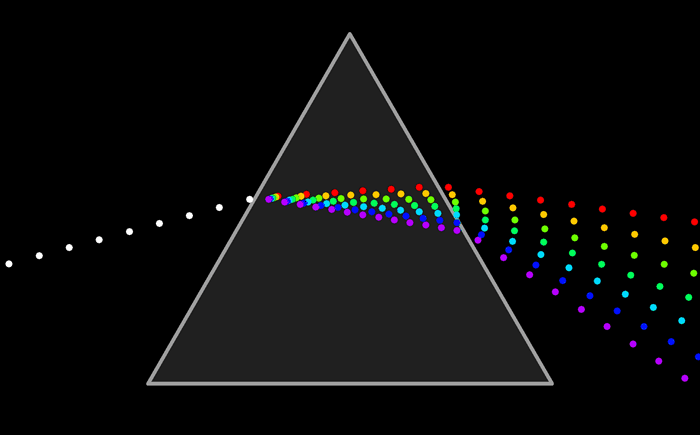.
Triangular prism (optics)

A triangular prism, dispersing light (*)
In optics, a triangular prism is a type of optical prism with the shape of a geometrical triangular prism. It is the most widely-known type of optical prism, although perhaps not the most common in actual use. Triangular prisms are used to disperse light, that is to break light up into its spectral components. This dispersion occurs because the angle of refraction is dependent on the refractive index, which in turn is dependent on the wavelength. This effect can also be used to measure the refractive index of the prism's material with high accuracy. In such a measurement, the prism is placed on the central rotary platform of an optical spectrometer with the incident light beam adjusted such that the refracted beam is at minimum deviation. The refractive index can then be computed using the apex angle and the angle of minimum deviation.
Although the refractive index is dependent on the wavelength in every material, some materials have a much more powerfull wavelength dependence (are much more dispersive) than others. Normal optical BK7 glass has a relatively small dispersion, while glass types such as LaSF11 or Lanthanum dense flint glass have a much stronger dispersion and hence are more suitable for use in dispersive prisms.
The top angle of the prism (the upper corner in the accompanying picture) can be chosen to influence the exact dispersion characteristics. However, it is typically chosen such that both the incoming and outgoing light rays hit the surface approximately at the Brewster angle, so that reflection losses are minimized. An example is the use of this type of prisms in prism compressor for generation of ultrafast laser pulses.
The prism is also seen on the cover of Pink Floyd's The Dark Side of the Moon. The graphic on the album cover shows the ray of light remaining white while passing through the prism and only refracting to the entire visible light spectrum upon leaving the prism. This image is inaccurate because the different wavelength of different colours of light cause them to refract as soon as they enter the prism. the light then creates lights in the designated places.
Retrieved from "http://en.wikipedia.org/"
All text is available under the terms of the GNU Free Documentation License

